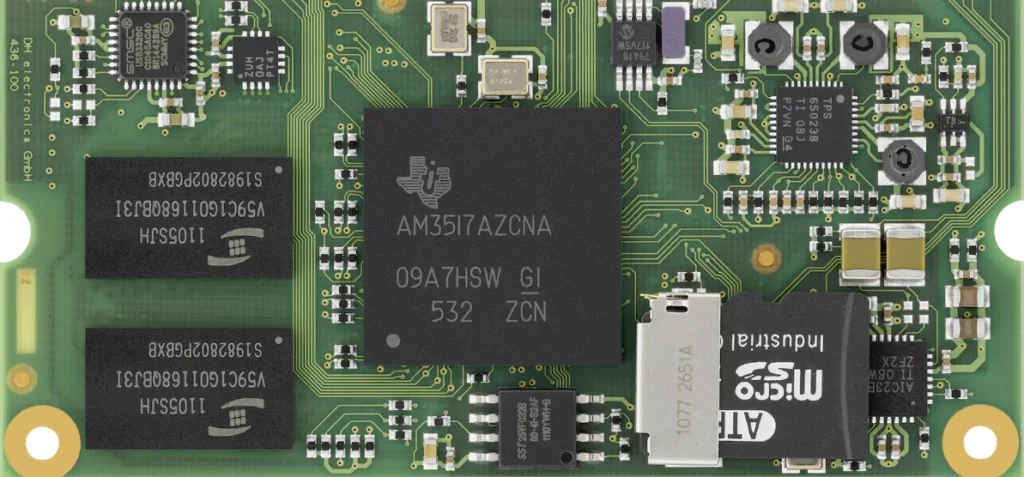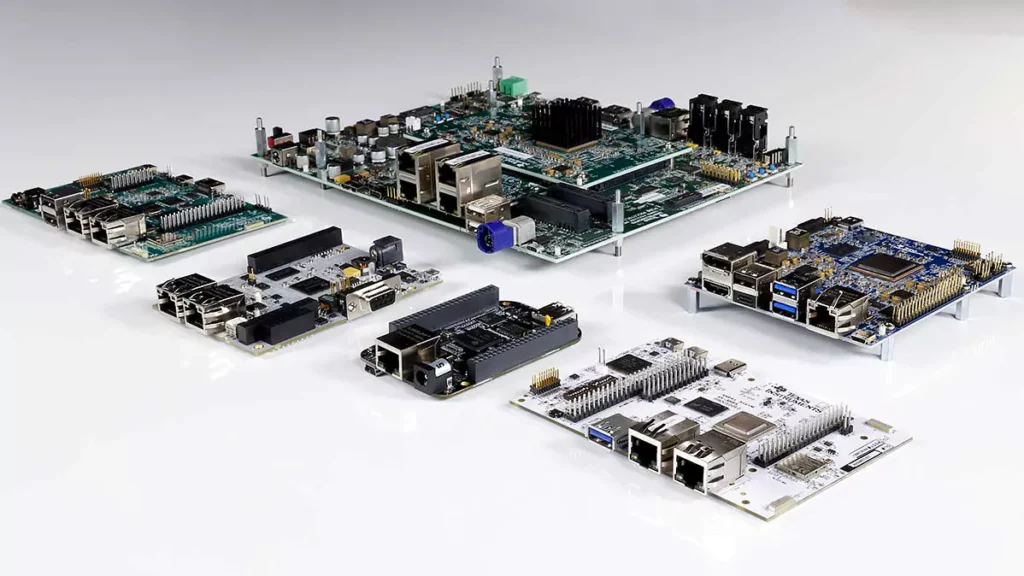An embedded processor is a specialized microprocessor designed to perform specific tasks within a larger system or device. Unlike general-purpose processors found in computers, embedded processors are optimized for power efficiency, cost-effectiveness, and real-time performance.
What Does Embedded Processor Mean?

In essence, an embedded processor is the “brain” of a device, controlling its functions and interacting with its environment.
Embedded processors are specialized integrated circuits designed to perform specific tasks within a larger system. Tailored for power efficiency, they often feature streamlined designs and are capable of deterministic performance. Unlike general-purpose processors, embedded processors are highly customizable, allowing for optimization in terms of cost, size, and power consumption. This makes them ideal for a wide range of applications, from consumer electronics to industrial automation.
Types of Processors in Embedded Systems

Microcontroller
The heart of many embedded systems.
Integrated circuit combining a CPU, memory, and peripherals on a single chip.
Optimized for power efficiency, cost-effectiveness, and real-time performance.
Widely used in consumer electronics, automotive systems, and industrial control.
Microprocessor
The CPU component of a computer system.
More powerful than microcontrollers, offering higher performance and flexibility.
Often used in high-performance embedded systems like digital signal processing (DSP) or image processing.
Digital Signal Processor (DSP)
Specialized for processing analog signals converted into digital format.
Excellent at handling mathematical calculations required for audio, video, and communication systems.
Used in applications like modems, digital cameras, and audio players.
Application-Specific Integrated Circuit (ASIC)
Designed for a specific function, offering optimal performance and power efficiency.
Not as flexible as general-purpose processors but excels in dedicated tasks.
Examples include graphics processing units (GPUs) and network processors.
System on a Chip (SoC)
Integrates multiple components, including a processor, memory, peripherals, and often dedicated hardware accelerators, on a single chip.
Provides high performance, low power consumption, and reduced system cost.
Commonly used in smartphones, tablets, and other complex embedded systems.
Other Types
General-Purpose Processors (GPPs): Used in some embedded systems that require high computational power, such as industrial automation or robotics.
Field-Programmable Gate Arrays (FPGAs): Highly flexible devices that can be configured to perform various functions, offering a balance between ASICs and general-purpose processors.
Difference Between Embedded Processor and Microprocessor
A microprocessor is a general-purpose processing unit responsible for executing computations and managing data flow in a variety of devices, including computers, laptops, and servers. It forms the core of a computer’s CPU (Central Processing Unit) and is designed to handle a wide range of tasks.
Microprocessors are versatile, capable of running complex operating systems like Windows, Linux, or macOS, and are built with architectures such as x86 or ARM to maximize performance and flexibility. They are commonly found in environments where high computational power and the ability to perform multiple processes are essential, but they typically consume more power due to their extensive capabilities.
In contrast, an embedded processor is a specialized type of microprocessor that is specifically designed for a dedicated task within an embedded system.
Embedded systems are often part of a larger device, and their primary function is to perform a specific operation efficiently and reliably. Examples of embedded systems include those found in washing machines, automotive control systems, and smart devices. Embedded processors are optimized for the task at hand, often running real-time operating systems (RTOS) or even operating without an OS, depending on the application’s requirements.
These processors usually have simpler architectures, such as ARM Cortex-M or RISC-V, which are tailored for power efficiency, low cost, and integration of peripherals like timers and communication interfaces directly onto the chip. Embedded processors are commonly part of a System-on-Chip (SoC), which includes memory and I/O peripherals, minimizing the need for additional external components.
While microprocessors are used in general-purpose computing environments requiring high flexibility and performance, embedded processors are designed for specific, often repetitive, tasks where efficiency and reliability are key.
They are cost-effective and power-efficient, making them ideal for applications in devices like smartphones, industrial machines, and IoT (Internet of Things) devices.
Advantages of Embedded Processors
One of the key advantages of embedded processors is their ability to operate in real-time. Real-time performance means that the processor can handle inputs and produce outputs within a predetermined time frame, a feature that is vital in systems like automotive controls, where delayed processing could lead to failures or accidents.
The deterministic nature of embedded processors, where their behavior and output timing are predictable, contrasts with the more flexible but less predictable performance of general-purpose processors.
Application of Embedded Processors
Embedded processors are also integral to the development of smart and connected devices within the Internet of Things (IoT) ecosystem. These processors enable IoT devices to collect, process, and transmit data with minimal power consumption, ensuring that devices can function for extended periods on small batteries or even energy-harvesting technologies.
The integration of wireless communication capabilities within embedded processors further facilitates the seamless connection of these devices to the broader network, allowing for real-time data exchange and remote control.
Another significant aspect of embedded processors is their role in enhancing security within embedded systems. As these processors are often used in critical applications, the need for robust security features is paramount. Embedded processors can incorporate hardware-level security measures, such as encryption engines, secure boot processes, and tamper detection, to protect sensitive data and ensure the integrity of the system.
Furthermore, the customization potential of embedded processors allows for tailored solutions that meet the specific needs of various industries. For example, in the automotive industry, embedded processors can be customized to support advanced driver-assistance systems (ADAS), offering features like collision detection, lane departure warnings, and autonomous driving capabilities.
In the industrial sector, embedded processors can be optimized for controlling machinery, monitoring production lines, and managing energy consumption, contributing to increased efficiency and reduced operational costs.
In contrast, while microprocessors provide the computational backbone for general-purpose computing devices, their applications are broader but less specialized. They excel in environments where versatility and the ability to perform a wide array of tasks are essential, but they may not offer the same level of efficiency, reliability, or real-time performance as embedded processors in specific, mission-critical applications.
Conclusion
In summary, while microprocessors serve as the general-purpose workhorses of the computing world, embedded processors are the specialized tools that power the myriad of smart, connected, and critical systems that define modern technology. Their ability to deliver reliable, efficient, and real-time performance in constrained environments makes them indispensable across various industries, from consumer electronics to industrial automation, and beyond.